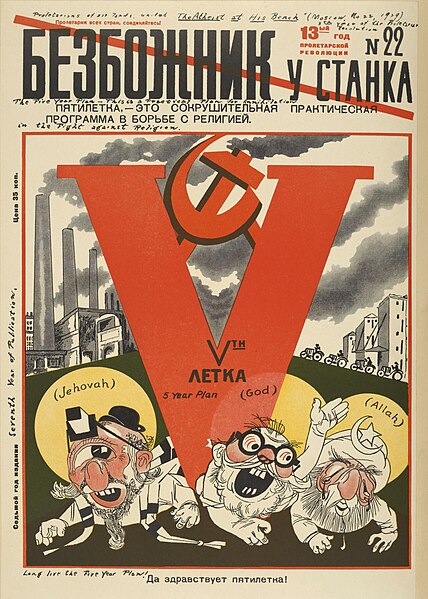Marxist–Leninist atheism, also known as Marxist–Leninist scientific atheism, is the antireligious element of Marxism–Leninism. Based upon a dialectical-materialist understanding of humanity's place in nature, Marxist–Leninist atheism proposes that religion is the opium of the people; thus, Marxism–Leninism advocates atheism, rather than religious belief.
Ludwig Feuerbach, who separated philosophy from religion to allow philosophers the freedom to interpret the material reality of nature
Karl Marx, who synthesized anti-religious philosophy with materialism to show that religion is a social construct used for social control by the ruling class of a society
Friedrich Engels, who identified religion as a person's need for a fantastic spiritual reflection of the self, by which to have some control over life and reality
The painting Bolshevik by Boris Kustodiev depicts a Bolshevik revolutionary, bearing the red flag, glaring at an Eastern Orthodox church
USSR anti-religious campaign (1928–1941)
The USSR anti-religious campaign of 1928–1941 was a new phase of anti-religious campaign in the Soviet Union following the anti-religious campaign of 1921–1928. The campaign began in 1929, with the drafting of new legislation that severely prohibited religious activities and called for an education process on religion in order to further disseminate atheism and materialist philosophy. This had been preceded in 1928 at the fifteenth Party congress, where Joseph Stalin criticized the party for failure to produce more active and persuasive anti-religious propaganda. This new phase coincided with the beginning of the mass collectivization of agriculture and the nationalization of the few remaining private enterprises.
"Monks - the bloody enemies of the working people" (Banner on the Dormition Cathedral of the Kiev Cave Monastery, 1930s.)
Cover of Bezbozhnik u Stanka in 1929, magazine of the Society of the Godless. The first five-year plan of the Soviet Union is shown crushing the gods of the Abrahamic religions.






